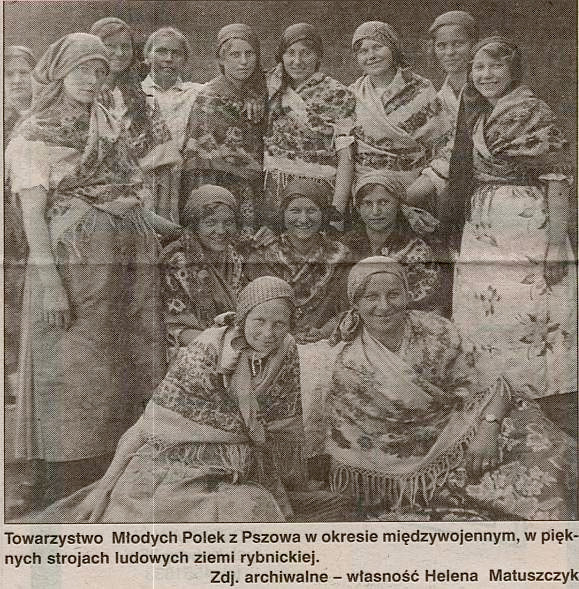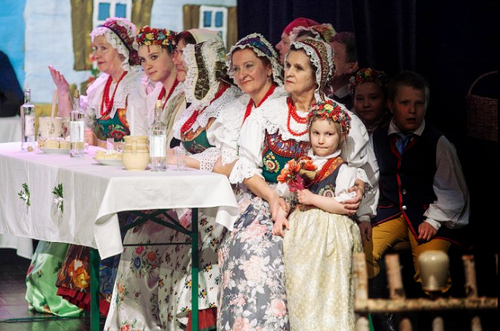Hello all,
Today I will try to give an overview of the folk costumes of Poland. This is a rather complicated subject, because the history of Poland is long and complex, and the borders have fluctuated greatly throughout history. The current borders date from the end of WWII, and by design resemble those of the kingdom of Mieszko in the late 900's. .
When I first began to study Polish culture, I was informed that there were 5 macroregions that covered all of Poland; Pomerania in the northwest, Silesia in the southwest, Wielkopolska in the west central region, Mazowsze in the northeast and Malopolska in the southeast.
It should come as no surprise that the reality is somewhat more complicated. Here is a true map of the historical regions of Poland. This map divides the territory to a great extent, splitting both Pomerania and Silesia into subregions. Each of these has a historical basis, however.
One thing which I have noticed, and about which some of my readers have inquired, is that none of my Polish books address the Polish colonies and enclaves which lie outside of the current borders, except for the Goral and Wlach enclaves in Moravia and Slovakia. Those which lie in Ukraine, Belarus and Lithuania are generally ignored. This may likely be due to Soviet pressure. I have found little information on their dress, and in any case, many of them were townspeople who did not wear folk costume. I will proceed roughly clockwise from the southwest.
Silesia
This area was subject to colonization from the west, call the Ostsiedlung, starting in the 10th cent., primarily by Germans, but also by Dutch and others. Those who identified as German were mostly removed after WWII. At the beginning of the Ostsiedlung, many Slavs still identified more with their local tribe than with the kingdom. There was much assimilation.
https://en.wikipedia.org/wiki/Silesia
Upper Silesia
This is the area shown in dark brown on the map above. There are some who hold to a Silesian identity, rather than Polish, and claim their dialect to be a distinct, although closely related language. There are a few distinct folk costumes which have been retained.
In general, upper and lower in place names refer to altitude.
Cieszyn
Pszczyna
Rozbarsk or Bytom
Rybnik
Raciborz
Opole
Lower Silesia
This area was much more heavily colonized than upper Silesia. Only one folk costume is recorded from this area, although there is great variety in the bonnets. Much of this area has no recorded folk costume at all. This area is indicated in a couple shades of light brown on the map.
Lusatia
This region is often lumped in with Silesia; it is indicated by the light green in the lower left on the map above. This is the homeland of the Sorbian people. The greater part of their territory is in eastern Germany, but a small portion of both Upper and Lower Lusatia today lie within Poland. I have found little about the Polish portion of this region, except that apparently the Sorbian languages are no longer spoken there.
https://en.wikipedia.org/wiki/Lusatia
Upper Sorbian
This is the costume that was worn in the area around Łęknica, [ Wjeska in Upper Sorbian], near Mużaków on both sides of the current border.
Lower Sorbian
This is the costume from the bend of the Oder, around Cybinka.
Lubusz Land
This region is in west central Poland, between Silesia and Pomerania and west of Wielkopolska. It is shown in pale pink at the left of the map above. Little has survived of the folk culture of this region due to assimilation.
https://en.wikipedia.org/wiki/Lubusz_Land
The folk costume which is used to represent this region comes from the eastern edge, between Międzyrzecz and Babimost, including Dąbrówka Wielkopolska. I believe that this area is shown on the map as western Wielkopolska.
Wielkopolska
This region is located in the west central part of Poland, centered on the city of Poznan. It is shown in bright red on the map. There were some colonists here, but the indigenous Polish inhabitants were assimilated only to a small degree.
https://en.wikipedia.org/wiki/Greater_Poland
Szamotuły
This area lies in the northwest of Wielkopolska.
https://en.wikipedia.org/wiki/Szamotu%C5%82y
I have written an article about this costume.
https://folkcostume.blogspot.com/2017/02/costume-of-szamotuy-wielkopolska-poland.html
Grodzisk Wielkopolski
This lies in the southwest, the costume is similar to that of Szamotuły.
Kościan
This lies to the east of Grodzisk
Biskupizna
This region lies in south central Wielkopolska. The amazing tulle confection used as a headdress was originally worn only by unmarried young women of courting age. This rule is often ignored today.
Here we see the traditional married women's headdress on the right.
Young girls wear a simplified version, as we can see here in the right foreground.
Kalisz
This area is in southeast Wielkopolska.
Bamberk
This costume is worn in the vicinity of the city of Poznan. Many of the inhabitants are descended from colonists from the vicinity of Bamberg, Germany, hence the name. This costume almost rivals that of Zywiec.
Pałuki
This region lies in the northeast of Wielkopolska.
Kuyavia and vicinity
This area lies in north central Poland, between Pomerania, Wielkopolska, Mazowsze and the old Prussian lands.
Kujawy
This region lies east and a little north of Wielkopolska. The costume culture has similarities to that of Wielkopolska, especially Paluki. It is shown in forest green on the map.
https://en.wikipedia.org/wiki/Kuyavia
I have written a full article about this costume.
https://folkcostume.blogspot.com/2012/07/costume-and-embroidery-of-kujawy-poland.html
Dobrzyń Land
This region lies east of Kujavia. It is shown in moss green on the map. The costume is similar to that of Kujawy.
Chełmno land
This lies north of Kujawy and Dobrzyn Land, and is shown on the map in pale blue. The western part [around Chelmno] has costumes related to Kujawy and Dobrzyn, but in the eastern part [around Lubawa] the culture is derived more from the Prussians.
https://en.wikipedia.org/wiki/Che%C5%82mno_Land
Krajna
This region lies between Wielkopolska and Pomerania. It is shown in rusty red on the map.
https://en.wikipedia.org/wiki/Krajna
Pomerania
This means 'The Land by the Sea'. It lies in northwest Poland, and also in northeast Germany. This area was heavily colonized, the native Slavic population was assimilated, and much of the folk culture has been forgotten. A few local costumes are remembered, some claimed by the Germans as much as by the Polish. Assimilation is evident, as even those who identify as German do a version of Krakowiak. This area is shown in various shades of blue on the map.
https://en.wikipedia.org/wiki/Pomerania
Pyrzyce
This lies in the southwest part of Polish Pomerania. Local history says that many Dutch were invited to settle here to drain the wetlands. Once drained, the soil proved to be very rich, resulting in the locals becoming wealthy and developing a rich costume.
https://en.wikipedia.org/wiki/Pyrzyce
I have written a full article on this costume.
https://folkcostume.blogspot.com/2017/01/costume-and-embroidery-of-pyritz.html
Jamno lies on the coast in the center of Polish Pomerania, roughly at the western edge of the light blue area on the map.
https://en.wikipedia.org/wiki/Jamno,_Koszalin
I have written an article on this costume.
https://folkcostume.blogspot.com/2016/11/costume-of-jamund-jamno-pomerania.html
Leba Kaszubs or Slovincians
These people lived along the coast of the Slupsk region around Leba, were Lutheran, and spoke a dialect of Kaszubian. https://en.wikipedia.org/wiki/Slovincian_Coast
https://en.wikipedia.org/wiki/Slovincian_language
Kaszubia
The Kaszubs live in the east end of Pomerania, around the city of Gdansk and areas inland. They speak a group of dialects that are only partially intelligible with Polish.
https://en.wikipedia.org/wiki/Kashubians
The original costume has been mostly forgotten, with the exception of the women's caps with gold embroidery. There has been some attempt to reconstruct it.
However the gold embroidery of the original caps inspired a style of colorful embroidery on linen. This became popular in the early 20th cent. and was used on linens, and also on a costume which the Kaszubs constructed for themselves. This costume is what is most commonly seen today. The old gold embroidery continues to be used on the caps, and sometimes on the bodices.
Kociewie
This is a region which is found southeast of Kaszubia. The local people speak a dialect which is much closer to standard Polish. They live around the vicinity of Starogard. There is a performing group in the village of Janowo. This causes some confusion, because there are many villages by this name scattered around Poland.
https://en.wikipedia.org/wiki/Kociewie
That is enough for one article. I will continue this subject in two more articles.
Thank you for reading, I hope that you have found this to be interesting and informative.
Roman K.
email: rkozakand@aol.com
Here is a website with a good map and many great photographs.
http://polishcostumes.tumblr.com/regions






























































































Dear Roman: Once more you've led us into interesting places! The tulle embroideries are simply superb - I want to drop everything and grab some thread and tulle. And the reminders of previous posts are welcome - and inspiring. Thank you.
ReplyDeleteThanks for this post. Your collection of best costumes are very beautiful ad attractive.
ReplyDeleteKindly visit:-
Costumes for hire
Great blog you havve here
ReplyDeleteFor costumes of Polish people eastward of the current border you might want to check out the Tumblr blog wschodnipolacy.tumblr.com.
ReplyDeleteGreat blog..
ReplyDeleteThank you for your work! It's sad to see how hundreds of years of traditions are being reduced to exaggerated "costumes". Especially when the originals are so detailed and luxurious with so much work put into them. I hope our traditions are never forgotten but nurtured further and appreciated
ReplyDeleteI’m from Pomerania, i want to sew the costumes, i already started with the Pyritzer one. At the start it was a bit confusing as I’m German and the claim by Polish people felt of as it is the Traditional clothing my great great grandparents would have worn, but after some reflection I came to the conclusion that I don’t know if my great great parents have seen themselves as German or Polish, DNA vise I probably have close in my family tree a Polish person, so who knows. Also I see my self as Pomerania first so other Pomeranians practicing Pomeranian culture should not be a problem to me, no matter their Nationality:3
ReplyDeletegermans were never the only people in pomerania. in fact, "germany" did not exist until very recently
Delete